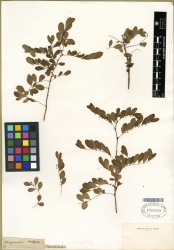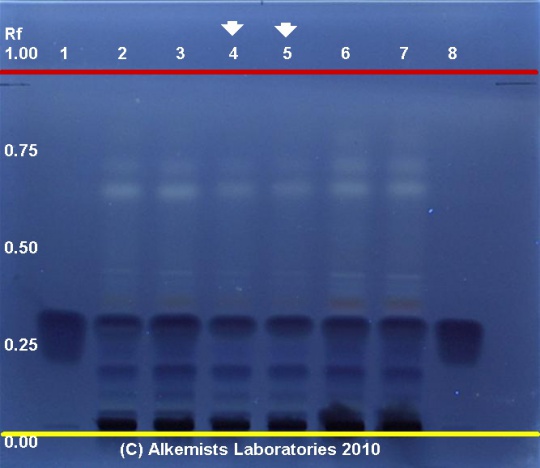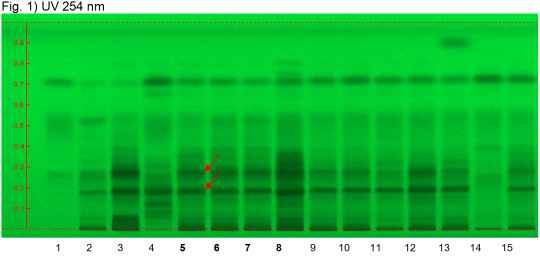Phyllanthus emblica (fruit)
Contents |
Nomenclature
Phyllanthus emblica L. Euphorbiaceae
Syn. Emblica officinalis Gaertn.
Standardized common name (English): amla
Ayurvedic name(s): amalaki
Pinyin name(s): yu gan zi (fruit)
Botanical Voucher Specimen
|
|
Organoleptic Characteristics
Macroscopic Characteristics
Microscopic Characteristics
 |
 |
|
|
|
High Performance Thin Layer Chromatographic Identification
|
Amla (fruit) (Phyllanthus emblica) Lane Assignments Lanes, from left to right (Track, Volume, Sample):
Reference materials used here have been authenticated by macroscopic, microscopic &/or TLC studies according to the reference source cited below held at Alkemists Laboratories, Costa Mesa, CA. Stationary Phase Silica gel 60, F254, 10 x 10 cm HPTLC plates Mobile Phase toluene: ethyl formate: formic acid [5/4/1] Sample Preparation Method 0.3g+3mL 70% grain EtOH sonicate/heat @ 50° C ~ 1/2 hr Detection Method 10% Methanolic H2SO4 -> 115° C 15 min -> UV 365 nm Reference see Indian Herbal Pharmacopoeia Vol 2 1999
|
|
Amla (fruit) (Phyllanthus emblica) Lane Assignments Lanes, from left to right (Track, Volume, Sample):
Reference Sample(s) Reference: Dissolve 1 mg of chebulinic acid and 2 mg gallic acid in 10 mL of methanol. Optional: dissolve 1 mg of ellagic acid in 10 mL of methanol. Stationary Phase Stationary phase, i.e. Silica gel 60, F254 Mobile Phase Ethyl formate, toluene, formic acid, water 30:1.5:4:3 (v/v/v/v) Sample Preparation Method Sample: Mix 1.0 g of powdered sample with 10 mL of methanol and sonicate for 10 minutes, then centrifuge or filter and use the supernatants/filtrates as test solutions. Derivatization reagent: 1.) NP reagent Preparation: 1 g of natural products reagent in 200 mL of ethyl acetate 2.) PEG reagent Preparation: 10 g of polyethylene glycol 400 in 200 mL of dichloromethane Use: Heat plate for 3 min at 100°C, dip (time 0, speed 5) in NP reagent, dry, dip (time 0, speed 5) in PEG reagent Detection Method Saturated chamber; developing distance 70 mm from lower edge; relative humidity 33% Other Notes Images presented in this entry are examples and are not intended to be used as basis for setting specifications for quality control purposes. System suitability test: Chebulinic acid: a quenching zone at Rf ~ 0.26 (UV 245 nm). Gallic acid: a quenching zone at Rf ~ 0.71 (UV 245 nm). Identification: Compare result with reference images. The fingerprint of the test solution is similar to that of the corresponding botanical reference sample. Additional weak zones may be present. Under UV 254 nm the test solution shows two characteristic quenching zones, one at Rf ~ 0.68 (red arrow) below the zone corresponding to gallic acid and the other at Rf ~ 0.14 (yellow arrow). After derivatization under UV 366 nm the test solution shows two characteristic and very intense fluorescent zones at Rf ~ 0.08 and 0.20 (pink arrows). Test for other species: No quenching zone is seen under UV 254 nm at Rf ~ 0.39 (Chebulic myrobalan fruit; black arrow). No blue fluorescent zone is seen under UV 366 nm at Rf ~ 0.52 (Belleric myrobalan fruit, green arrow). Source: HPTLC Association [5] |
|
Triphala powder (mixture of Phyllanthus emblica, Terminalia bellerica, Terminalia chebula) Lane Assignments Lanes, from left to right (Track, Volume, Sample):
Reference Sample(s) Reference: Dissolve 1 mg of chebulinic acid and 2 mg of gallic acid in 10 mL of methanol. Optional: dissolve 1 mg of ellagic acid in 10 mL of methanol. Stationary Phase Stationary phase, i.e. Silica gel 60, F254 Mobile Phase Ethyl formate, toluene, formic acid, water 30:1.5:4:3 (v/v/v/v) Sample Preparation Method Sample: Mix 1.0 g of powdered sample with 10 mL of methanol and sonicate for 10 minutes, then centrifuge or filter and use the supernatants/filtrates as test solutions. Derivatization reagent: 1.) NP reagent, Preparation: 1 g of NP reagent in 200 mL of ethyl acetate; 2.) PEG reagent, Preparation: 10 g of polyethylene glycol 400 in 200 mL of dichloromethane, Use: Heat plate 3min at 100°C, dip (time 0, speed 5) in NP reagent, dry and dip (time 0, speed 5) in PEG reagent. Detection Method Saturated chamber; developing distance 70 mm from lower edge; relative humidity 33% Other Notes Images presented in this entry are examples and are not intended to be used as basis for setting specifications for quality control purposes. System suitability test: Chebulinic acid: a quenching zone at Rf ~ 0.26 (UV 245 nm). Gallic acid: a quenching zone at Rf ~ 0.71 (UV 245 nm). Identification: Compare result with reference images. The fingerprint of the test solution is similar to that of the corresponding botanical reference sample. Additional weak zones may be present. Under UV 254 nm the test solution shows several diffuse quenching zones above the application position. The two main quenching zones are detected at Rf ~ 0.19 and Rf ~ 0.28 (red arrows). Above these zones there are additional diffuse quenching zones. There are quenching zones at the position of ellagic acid and of gallic acid. Under UV 366 nm two blue fluorescent zones are detected right above the application position (yellow arrow). Several intense blue fluorescent zones are present between Rf ~ 0.16 and 0.40. At the position of gallic acid there is a fluorescent zone. Source: HPTLC Association [6] |
Supplementary Information
Sources
- ↑ MOBOT, Tropicos.org http://www.tropicos.org/Image/100170197
- ↑ Elan M. Sudberg, Alkemist Laboratories http://www.alkemist.com
- ↑ Elan M. Sudberg, Alkemist Laboratories http://www.alkemist.com
- ↑ Elan M. Sudberg, Alkemist Laboratories http://www.alkemist.com
- ↑ HPTLC Association http://www.hptlc-association.org/
- ↑ HPTLC Association http://www.hptlc-association.org/










